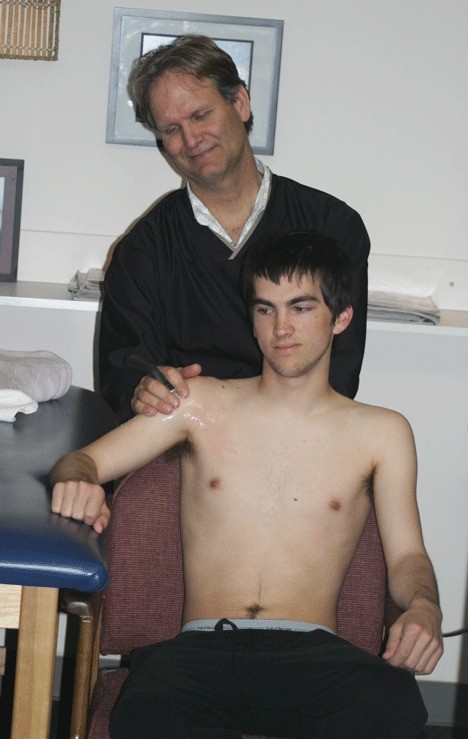Ken’s Korner — When former Falcon Dakota Hanna hurt his shoulder playing football last October, he knew where to go.
“I needed some help for about nine weeks so I could play baseball,” Hanna said. “Fortunately, the doctor said I wouldn’t need surgery, just therapy. So I came to see Jim.”
For more than 15 years, Jim Christensen has been providing intensive physical therapy to local athletes suffering injuries to knees, ankles and shoulders — the three main body parts at risk to young kids playing high-intensity sports.
He also teaches a class designed to get high school students interested in physical therapy.
Hanna isn’t alone — among other recent patients were top Falcon female runner McKenzie Walker and this year’s state track-and-field champions Jon Poolman and Will Hallberg.
All three visited the Family Care Center at Ken’s Korner to attend to minor aches prior to state finals competition.
Christensen has from 200 to 500 treatment sessions per season, ranging from sprains and abrasions to more serious bone injuries. And though football and soccer injuries can be serious, most problems are related to track and cross country.
“Running problems are not as serious, but they’re persistent,” Christensen said. He’s found that girls play as hard as boys, but their bodies don’t handle stress as well.
“We see a lot of knee injuries from girls,” he said.
Ashley Lopez, an employee at the Family Care Center, knows that all too well. She moonlights as assistant coach for South Whidbey High School’s girls softball team.
“Shortstops and pitchers are especially vulnerable to getting hurt; one from rotating from one position to another very fast, the other from constant throwing,” she explained.
Lopez added that a typical treatment includes electrical stimulation and manual therapy that relaxes the muscles.
“Then we use therapeutic exercises, both simple and complex, to strengthen the muscles,” she said.
Christensen is a certificated teacher, running a class at the high school with an eye to exposing young people to future medical careers. Christensen’s sports-medicine program offers students the chance to study the care, prevention and evaluation of athletic injuries; basic first aid; medical terminology; basic emergency trauma situations; mechanisms of injury, rehabilitation, human anatomy; and other topics related to health occupations.
“The more information we can impart in the classroom and through student trainers on-site, the less chance for long-term repercussions,” he said.
Students are trained to assist athletic teams and their coaches
They can spend equal amounts of time in the classroom or as interns at athletic venues, earning both one classroom credit and one work experience credit.
“Quite a few have gone on to medical-related studies in college,” Christensen said.
Jeff VanDerford can be reached at 221-5300 or jvanderford@whdbeynewsgroup.com.



